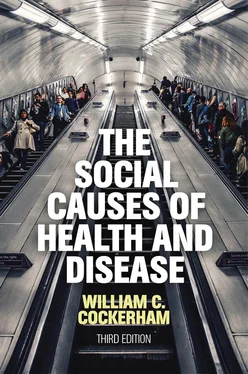Smoking is associated with more diseases than any other health-related lifestyle practice. Smoking tobacco or using tobacco products in any form harms health (Cockerham 2013b). Autopsies on heavy smokers show lung tissue that transformed from a healthy pink to gray and brownish white in color. Smoking also affects the body in other ways, such as damaging the cardiovascular system, causing back pain, and producing increased risk of loss of cartilage in knee joints through osteoarthritis. The physiological damage caused by smoking cigarettes is due to the irritant and carcinogenic material (“tar”) released by burning tobacco into smoke that is inhaled in the lungs and enters the blood stream where it is spread throughout the body. Persons who die from lung cancer are increasingly less able to breathe and feel suffocated as their lungs lose the capacity to transfer oxygen to the blood.
In Britain, some 114,000 people die annually from smoking. In the United States, with its much larger population, about 480,000 Americans die each year from smoking-related causes, including some 41,000 dying from exposure to second-hand smoke. Smoking promotes heart attacks and strokes, narrows and hardens arteries, damages blood vessels and causes them to rupture (aneurysms), and brings on high blood pressure. Habitual smoking regularly results in premature death, as smokers typically die 10 years earlier than non-smokers in the US. How do social variables enter into this disease pattern in a causal role? At one level it looks like the causal factors are all biology: tar in smoke causes cancer and impairs blood circulation. But tar by itself is not causal. It has to enter the human body to have any effect. What is ultimately causal is the human being – both as a host inhaling the smoke and as a producer of a smoking-prone social environment. There is a social pattern to smoking that indicates tobacco use is not a random, individual decision completely independent of social structural influences.
However, smoking and other risky behaviors have not been viewed in a broad social context by researchers as much as they have been characterized as situations of individual responsibility. If people wish to avoid the negative effects of smoking on their health, it is therefore reasoned that they should not smoke. If they choose to smoke, what happens to them is no one’s fault but their own. This victim-blaming approach does not explain why people, especially those from socially disadvantaged circumstances, are drawn to poor health habits like smoking and the types of social situations that promote this behavior. Today, smoking is highly unusual among persons at the higher and middle levels of society and is concentrated among people toward the bottom of the social ladder. Persons in higher socioeconomic groups were the first to adopt smoking in the early twentieth century and other social classes followed, but growing publicity about the harmful effects of cigarettes in the 1960s led to a shift in smoking patterns over time as better educated and more affluent groups began abandoning the practice (Antunes 2011; Cockerham et al. 2017b; Ho and Fenelon 2015; Narcisse et al. 2009; Pampel 2009). By the early twenty-first century, smoking patterns had drastically changed.
According to Mieke Thomeer and her associates (Thomeer et al. 2019), social connections are key predictors of smoking. Thomeer et al. found that the social connections in one’s life (i.e., parents, peers) were most important in influencing an individual to smoke or, conversely, avoid smoking. For those who quit smoking or relapsed after having stopped, the primary motivation was found to be changing social connections in adulthood (such as finding a new job with different co-worker friendships or the ending of an intimate relationship). One man, for example, starting smoking at age 11 because his father smoked, and he thought it was “cool.” A woman said she never smoked because her grandmother used to blow smoke in her face as a child and she couldn’t stand the smell. Smoking in these accounts typically begins and ends as an activity that involves other people. Among adolescents, however, the influence of peers is stronger in initiating smoking rather than ending it. As Steven Haas and David Schaefer (2014: 126) determined in a nationwide study in the US: “Adolescents rarely initiate smoking without peer influence but will cease smoking while their friends continue smoking.”
The social process of becoming a smoker was aptly described by Jason Hughes (2003) several years ago, who determined that confirmed smokers pass through five stages in their smoking career: (1) becoming a smoker, (2) continued smoking, (3) regular smoking, (4) addicted smoking, and, for some, (5) stopping smoking. Based on interviews with both smokers and ex-smokers in Britain, Hughes determined that the first experience people have with smoking cigarettes in the initial stage of becoming a smoker is typically unpleasant. The smoker usually feels nauseated. One respondent told Hughes (2003: 148) that she really did not like her first cigarette, describing it as “foul.” This raises a crucial question: If the first experience is unpleasant, why do people continue? Hughes’s answer is that people learn how to smoke by having other individuals interpret the experience for them and tell them how to distinguish the desired sensations from the undesirable. Specifically, they are taught how to inhale properly and pull the smoke into their lungs. One woman in the Hughes (2003: 149) study reported on what it was like being a smoker when she first started: “it was quite exciting. I thought I’d grown up! It was something new. And it is a skill that you have to learn to do it properly so that people don’t say, ‘she’s not inhaling properly, she’s not smoking.’ You have to learn how to do it.” Hughes explains that, initially, smoking is a social activity carried out with other people. It typically has its origins in adolescent peer groups, in which teens imitate adult or older teen behavior (de la Haye et al. 2019). Teens smoke to “connect with,” “fit in,” and “impress” their friends. Joy Johnson and her colleagues (Haines, Poland, and Johnson 2009; Johnson et al. 2003) studied teen smoking in Canada and found that adolescents are more socially than physically dependent on cigarettes in the beginning.
The social setting, namely relaxing with peers, caused smoking more than wanting to inhale tobacco smoke. Often the teen did not smoke when friends were not around. But when friends were present, new smokers used cigarettes primarily to connect with them socially, project an image of being “cool,” and express solidarity. Three teenagers in the Johnson et al. (2003: 1484–6) study analyzed smoking in their peer groups this way:
Like it [smoking] is a social aspect of their life that they have become dependent on, as much as the nicotine, you know. I think almost the social setting of it is something that is somewhat addictive itself. (17-year-old female)
People don’t really have to smoke, but they do it anyways to like fit in, or whatever, and they smoke to put out an image to people. (17-year-old male)
It’s more what you will do to fit in, not what you will do to smoke, because you may not actually want to smoke. (16-year-old male)
Reports such as these support Hughes’s (2003) contention that the beginning stage of becoming a smoker is principally a social experience. Not only are the techniques learned within peer groups, but the act of smoking is used to promote social relationships, reinforce personal bonds, and express group affiliation. Soon the adolescent smokers also learn to recognize the effect of nicotine on their emotions. Smoking helped them feel calm and reduced anxiety; it could also ease depression, sadness, fear, loneliness, and anger. Some novice smokers found they could like the taste and others felt smoking was a sign of transition to an adult identity. While many adolescents likely try smoking at some point in growing up, the majority do not continue. For those that do, however, they enter the second stage of smoking described by Hughes, that of continued smoking. Here the beginning smoker starts smoking more frequently as part of a consistent pattern of behavior. These smokers continue to use cigarettes to socialize, but also for other reasons like relaxation, pleasure, alleviating stress, or helping their concentration. They also smoke when they are alone, instead of just when they are with other people. They begin recognizing themselves as smokers and find they have a growing sense of dependence on the addictive qualities of nicotine as they move into the third stage of regular smoker in which smoking becomes a lifestyle habit that leads to the fourth stage of addicted smoking in which the smoker has to smoke a cigarette just to feel “normal.” As one addicted smoker (Johnson et al. 2003: 1488) put it: “It’s gone beyond maybe wanting it or enjoying it, but at this point, your body is addicted to it, and no matter what, you couldn’t get through the day without either thinking about it or feeling you need a cigarette” (19-year-old female).
Читать дальше












